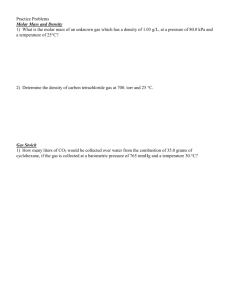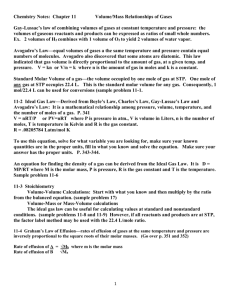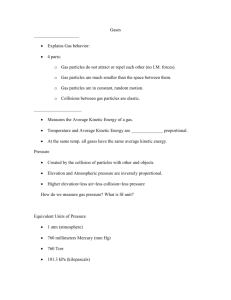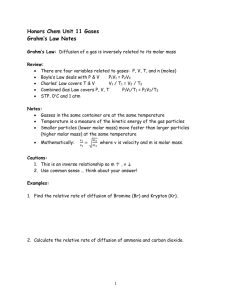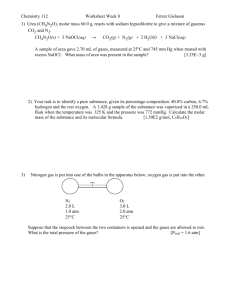Chapter 14 The Behavior of Gases
advertisement
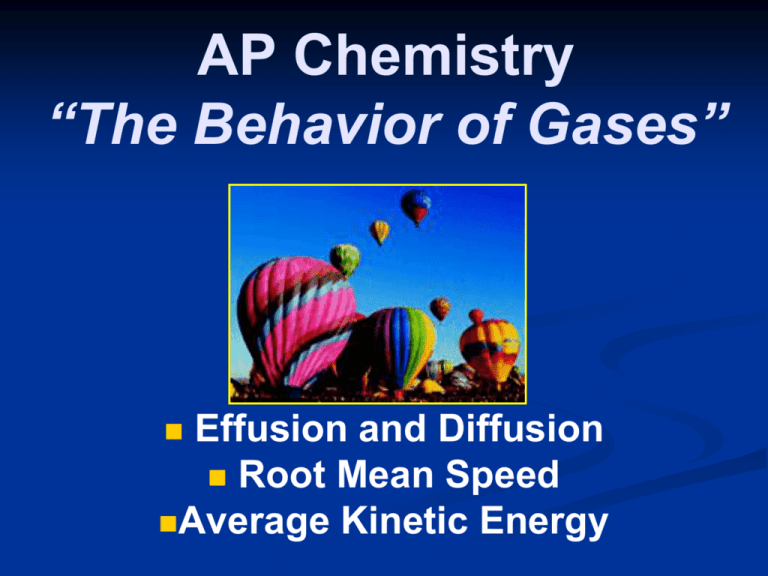
AP Chemistry “The Behavior of Gases” Effusion and Diffusion Root Mean Speed Average Kinetic Energy Diffusion is: u Molecules moving from areas of high concentration to low concentration. uExample: perfume molecules spreading across the room. Effusion: Gas escaping through a tiny hole in a container. Both of these depend on the molar mass of the particle, which determines the speed. •Diffusion: describes the mixing of gases. The rate of diffusion is the rate of gas mixing. •Molecules move from areas of high concentration to low concentration. Effusion: a gas escapes through a tiny hole in its container -Think of a nail in your car tire… Diffusion and effusion are explained by the next gas law: Graham’s Graham’s Law RateA RateB = MassB MassA The rate of effusion and diffusion is inversely proportional to the square root of the molar mass of the molecules. Derived from: Kinetic energy = 1/2 mv2 m = the molar mass, and v = the velocity. Comparing distance traveled You can compare the distanced traveled by 2 gases in the same amount of time using this equation also. Distance traveled by A = MassB Distance traveled by B MassA Graham’s Law Sample: compare rates of effusion of Helium with Nitrogen – With effusion and diffusion, the type of particle is important: Gases of lower molar mass diffuse and effuse faster than gases of higher molar mass. Helium effuses and diffuses faster than nitrogen – thus, helium escapes from a balloon quicker than many other gases! How much faster does methane (CH4) effuse than propane (C3H8)? Determine molar masses of each gas CH4 = 16.04 g/mol C3H8 = 44.09 g/mol Plug into formula Rate CH4 M C3H8 Rate C3H8 MCH4 = 44.09 = 1.65 16.04 This means that methane diffuses 1.65 times faster than propane gas Graham’s Law of Effusion Examples 1) A compound effuses through a porous cylinder 1.41 times faster than helium. What is it’s molar mass? Rate Gas x Rate He 1.41 = √4 √x = √He √X 1.41 (√x ) = 2 √x = 2/1.41 X = (1.41)2 = 2.01 g/mole = Hydrogen (H2) If 0.00251 mol of NH effuse through a hole 3 Assuming the time is the same, we can use the in 2.47relationship min, how following withmuch Graham’sHCl Law would effuse in the same time? Moles NH3 = Moles HCL √MHCl √MNH3 0.00251 Moles HCl = √36.45 √17 0.00251 Moles HCl = 1.46428 Moles HCl = 0.0017 Moles A sample of N2 effuses through a hole in 38 seconds. what must be the molecular weight of gas that effuses in 55 seconds under identical conditions? Moles / 55sec = √ MN2 Moles / 38sec √Mgas 38 55 = √28 √Mgas Mgas = 58.5 g/mol Molecular Speeds and Average Kinetic Energy The Kelvin temperature scale is a measurement of the average kinetic energy of gas particles. KE = ½ mv2 As kinetic energy increases, then the temperature increases, and molecules move faster. KEavg = 3 RT 2 Where = 8.3145 J/Kelvin Mole This formula represents the average energy of the particles at a given temperature. Maxwell Speed Distribution Curve •Peaks represent the average speeds •Remember, some are moving faster and some slower at the same temperature! •Peak moves to greater speed with higher temps. •Curve flattens due to more molecules moving at greater speeds. Root Mean Square Speed (or Velocity) rms or μrms (Units are meters/sec) Estimates the average molecular speed based on molecular mass and temperature. Μrms = √3RT √M M = Molar Mass in kg/mole R = 8.3145 J/K Mol T = Temperature in Kelvin This Formula relates the difference in speed (not kinetic energy!) to the molar mass of the gas. Maxwell Speed Distribution Curve •These are speed distribution curves for 3 different gases a the same temperature Oxygen (O2) Helium Hydrogen (H2) •Shows that lighter molecules (like hydrogen) move faster on average than heavier ones (like oxygen) Big Points to Remember: All gases at the same temperature have the same average kinetic energy. But, they do not have the same average velocity (or speed!) Speed depends on Molar Mass (root mean square speed!) The heavier the gas, the slower it moves! The lighter the gas, the faster it moves!
